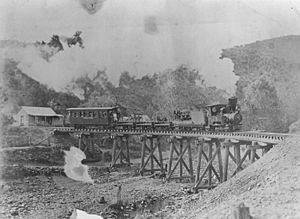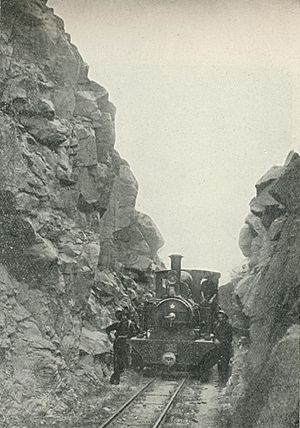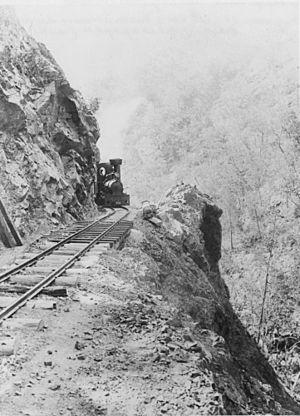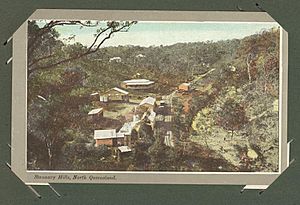Stannary Hills Tramways facts for kids
Quick facts for kids Stannary Hills Tramways |
|
|---|---|
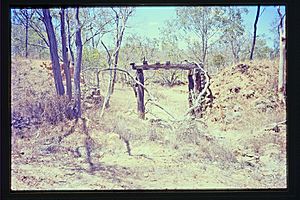
Tramway remains, 2003
|
|
| Location | Irvinebank, Shire of Mareeba, Queensland, Australia |
| Design period | 1900 - 1914 (early 20th century) |
| Built | 1901 - 1907 |
| Official name: Stannary Hills to Boonmoo and Stannary Hills to Irvinebank Tramway formations | |
| Type | state heritage (archaeological) |
| Designated | 25 February 2005 |
| Reference no. | 602355 |
| Significant period | 1901-1907 (fabric) 1902-1936 (historical) |
| Significant components | objects (movable) - mining/mineral processing, trees/plantings, weir, embankment - tramway, mounting block/stand, pole/s - telegraph, wall/s - retaining |
| Lua error in Module:Location_map at line 420: attempt to index field 'wikibase' (a nil value). | |
The Stannary Hills Tramways are two old tram lines in Queensland, Australia. They are located near Irvinebank in the Shire of Mareeba. These tramways were built between 1901 and 1907. They helped transport tin from mines in the area.
The tramways are now a heritage-listed site. This means they are protected because they are an important part of Queensland's history. They show how people moved goods and passengers in the early 1900s.
Contents
History of the Tramways
These two private tramways were very important for the tin mining areas west of the Atherton Tableland. They were used from when they were built until 1936. The tram lines were quite narrow, only 2 feet (0.61 m) wide. This was different from the standard 3 feet 6 inches (1.07 m) railway lines used by the government at the time.
Workers used local timber like cypress pine to build the tracks and bridges. One part of the tramway was called Dixon's tramway. It was named after the engineer, S. Dixon, who helped build the first section.
Discovering Tin and Early Transport
Tin was first found in this area in 1875 by James Venture Mulligan. More tin was found over the next few years. Before the tramways, Cobb and Co coaches were the main way to travel. They connected the mining areas to coastal ports like Port Douglas and Cairns.
In 1893, the government built a railway line from Cairns to Mareeba. This made people more interested in mining in the Herberton area.
Building the First Tramway
A company called North Queensland Tin Mining Corporation was formed in 1899. They were interested in the Eureka Creek mines, which had been left because transport was too expensive. The closest government railway station was Boonmoo.
In 1901, a new company, Stannary Hills Mines and Tramway Company Limited, was created. They wanted to build a tramway from Boonmoo to Stannary Hills. This company was one of the first to use new laws that allowed tramways to carry goods and people, not just minerals. This helped attract money for mining in Queensland.
Construction started in early 1901. The tramway reached Stannary Hills in 1902. Building the line was easy at first. But closer to Stannary Hills, they had to cut around hills to make the track level enough for the trams.
After opening, the line was extended 11 kilometres (6.8 mi) to Rocky Bluff. This was a place where tin ore from Eureka Creek could be processed.
The "Shaking Moses" Battery
At Rocky Bluff, a large machine called "Shaking Moses" was installed. It could crush 100 tons of ore a day. The tram line ended at the top of a steep slope above this machine. Firewood for the boilers and ore for crushing were lowered down this slope using a special tramway with two tracks.
Passengers could also ride the tram from Stannary Hills to Rocky Bluff. It cost 3 shillings sixpence for a one-way trip. There were no stations; people just waved to stop the tram.
John Moffat and the Irvinebank Line
John Moffat was a very important mining businessman in North Queensland. He needed better transport for his Loudoun Mill in Irvinebank. This mill used a lot of firewood, and supplies were running low.
So, Moffat decided to build another tramway. This new line would connect Stannary Hills to Irvinebank. This would link his tin mining operations to the existing Boonmoo line.
Construction of the Irvinebank section began in August 1906. About 150 men worked on it. They built cuttings, laid tracks, and constructed bridges. Workers were paid 8 shillings a day.
By 1907, Herberton and Irvinebank were major centers for tin production in Queensland. The new tramway had the potential to connect Moffat's mining empire to coal supplies, the port of Cairns, and even major cities like Brisbane and Sydney.
Opening Day and Daily Life
The first load of firewood arrived at Loudoun Mill by tram on March 28, 1907. John Moffat's company started carrying goods for the public in June 1907.
The official opening of the tramway was a big party! John and Margaret Moffat hosted a picnic for 1500 guests on June 29, 1907. Businesses closed, and everyone from Irvinebank was there. There were sports, dancing, and even a steam merry-go-round.
For two decades, the Stannary Hills to Irvinebank tramway was the most reliable way to travel. Important people, like the Governor William MacGregor, used it to visit John Moffat. Passengers rode in a carriage attached to wagons carrying coke and supplies. The 21-mile trip took four hours.
In the first year, the tramway moved over 61,000 tonnes of freight and nearly 8,700 passengers.
Social Benefits and Decline
The tramway also brought many social benefits. It helped people in the tin industry get around. It was used for picnics and special events. The trams also carried everyday goods like kerosene, ice, fruit, vegetables, beer, and mail.
John Moffat retired in 1912. The First World War made things harder for the tin mines. In 1919, the Queensland Government bought the mining works and the tramway.
The Loudoun Mill reopened as the Irvinebank State Treatment Works. In 1922, the government also bought the Stannary Hills to Rocky Bluff line. All the locomotives (train engines) were then moved to Irvinebank. The section from The Junction to Stannary Hills was taken apart in 1926.
After some attempts to restart mining, the tramway stopped running for good at the end of 1936. During the Second World War, the government sold off anything useful from the mines. The rails were taken up and sold to sugar cane and other mining tramways. Some parts were even used for the Port Douglas tramway, which is still used by the Mossman Mill today.
Tramway Routes
You can see a map of the routes in the Chillagoe Railway & Mining Co. article.
- Main line:
* Boonmoo * Stannary Hills * Irvinebank Junction
- North branch:
* Rocky Bluff
- South branch:
* Irvinebank
What the Tramways Look Like Today
Today, you can still see parts of the two old tramways. They stretched for about 29 kilometres (18 mi) between Irvinebank and Boonmoo. One line went from Boonmoo to Rocky Bluff, passing through Stannary Hills. The other went from The Junction to Irvinebank. Remember, these lines were only two feet wide.
Near Boonmoo, there isn't much left of the tramway. But as you go along Eureka Creek, you can see where the track was cut into the hillsides. There are also stone walls that held up the track. You might find ruins of bridges and small cuttings.
About 10 miles from Boonmoo, you can see broken bricks. This marks the spot of an old brick factory next to the tramway. You might also spot old ore bins, which were used to hold minerals.
At Stannary Hills, two old mango trees mark where the tramway station used to be. You might find bits of glass and metal there. There are also remains of the old station building, including parts of the pit where they serviced the locomotives.
A concrete weir (a small dam) was built in Eureka Creek at Stannary Hills. This is also part of the heritage site. You can see parts of an old metal water tank nearby.
Further along, you'll find the site of the Black Bridge. Only concrete blocks and timber stumps are left of this large bridge.
The tramway split at a place called The Junction. One line went towards Rocky Bluff, and the other went to Irvinebank. You can still see cuttings in the ground where the tracks once ran.
As you get closer to Irvinebank, you'll see Yorkies Cutting. This is a noticeable cut into rocky ground, about 5 metres (16 ft) deep and 20 metres (66 ft) long. In some sandy areas, you can still see metal railway spikes where the track used to be.
There are also signs of old sidings, like Hales Siding. This was a small curved section of track. You might find old concrete floors, posts, and several old mango trees. These show where buildings and machinery once stood.
Even today, you can find small pieces of coal, slag (waste from smelting), and glass bottles along the old tramway path. You might also see parts of old telegraph poles that carried wires.
Further south, near Weinart Siding, you can see stone pitching (stones laid to support the track). You might also find parts of old telegraph poles and metal brackets.
Some areas have been disturbed by mining or farming. But in other sections, like from Chinaman Creek to Victoria Siding, the tramway path is very clear. Here, you can find many old tramway remains. These include a creek crossing with stone work and wooden poles. You might even see standing telegraph poles and old railway sleepers with spikes still in them.
The heritage area ends at a deep rock cutting at Games Flat. This spot is marked by a large mango tree and other interesting trees.
Why the Tramways are Important
The Stannary Hills Tramways are listed on the Queensland Heritage Register because they are very important to Queensland's history.
- They show how Queensland grew: These tramways, built between 1901 and 1907, played a big part in developing the tin mining areas in North Queensland.
- They are unique: They are a rare example of a 2 feet (0.61 m) gauge track. This type of private tramway was built especially for the mining industry to carry both goods and people.
- They can teach us more: There are still old mining tools, bottle dumps, local bricks, and bridge parts along the tramway. Studying these can help us learn more about Queensland's past.
- They are special to the community: The tramways have a strong connection to the tin mining community in North Queensland. They are also closely linked to the life and work of John Moffat.
- They are linked to an important person: The tramways have a special connection to John Moffat. He was a very important businessman in Queensland's history. He controlled mining developments in North Queensland from 1880 to 1912. Moffat built the Irvinebank to Stannary Hills tramway and owned it privately from 1906 to 1912.


